Genre: Platformer Developer: Headgames Publisher: Sega of America Players: 1 Released: 1994
The original Taz-Mania was a surprisingly good game. It had the feel of the cartoon, along with some wonderful locales and Taz himself, moved, sounded, and acted like the popular cartoon character should. It did have its flaws, such as some bad level design and music that was either absent or annoying, but the game was still a lot of fun. Turning it on after many years since I last saw it running was a pleasant surprise. After years since my last playthrough, my smile would have visibly broadened as I began enjoying it all over again.
The sequel eluded me (though I always wanted it) for the entire 16-bit generation, and I didn’t end up picking up Taz in Escape from Mars until only recently. When I first went to turn the console on, I was wildly optimistic that this would be a great game. After all, how wrong could it go? The original could only be improved upon, as far as I was concerned, and the setting for this game was so good as to almost guarantee a great time in my eyes. It was with naive enthusiasm then that I went on to tackle the ins and outs of this game and experience the few improvements along, with many shortcomings.
If you played the original, much of the presentation, graphics, and sound effects will feel immediately familiar to you from almost the moment the Sega logo fades. The game is still a single-player only adventure, and the options menu lets you simply re-arrange what buttons do what before setting out on your escape. Upon starting you are treated to an entertaining series of comic stills outlining the plot before literally being dropped right into the game. What is immediately noticeable is extra detail on the devil himself and generally a lot more colour than was seen in the last game. It won’t be much longer before you discover some clever new moves that have been included and thankfully without changing the simple controls from the first game. The first part is quite enjoyable, and though the initial levels look absolutely nothing like Mars, with the outer-space background and the strange fluoro-green Martians you encounter, reality doesn’t get in the way and shouldn’t. Initial impressions were quite positive; it had the same style with the same great character in a new setting and like all good sequels – extra features.
While I was enjoying the first world, I was also starting to get an early idea of the game’s weaknesses. The music in particular started bothering me early. In the original game, much of the sound effects and music were simple, but they did represent the cartoon well and certainly contributed, at some level, to the feeling you were playing a cartoon. Escape from Mars takes this and gives it a Marvin the Martian twist without actually improving anything. The sound effects are still entertaining and suit the game well but the tunes played throughout the levels are just as bad as in the first Taz. In each level the music seems to be the same simplistic “beeps” and “boops” re-arranged and sped up or down in different sequences. Because of this, each environment, while looking vastly different, sounds almost exactly the same.
The first world is basically what anyone who looks at box art would expect to see. Despite the games title indicating that the point of the whole game is to escape Mars, Taz accomplishes this after the first boss fight. From here Taz is on to Mole World, a planet that certainly lives up to its name. After that is Planet X, then strangely enough Mexico, a haunted castle and then Marvin’s House, which may have been back on Mars, but I’m not sure. I couldn’t help getting the feeling by this stage that the developers took one concept, ran out of ideas half-way, and proceeded to slap on the most derivative platform worlds they could to fill the rest of the game out. On the positive side, all the levels are varied, especially in visual style and there are plenty of different enemies encountered along with some visually impressive bosses.
Whether you played the original or not, you will find the angry little devil very easy to control. Taz runs, jumps and spins like in the last game, but this time around he gets a couple of new moves that make use of his spin attack. You can now spin underground at certain points (especially in Mole World); you can spin up walls, on ceiling and up ramps at certain points as well. You can even use the spin attack to spring yourself up narrow parallel walls. These are all great additions but they are ruined by poor level design. Taz-Mania had a lot of frustrating enemies, and I experienced many cheap deaths from unseen or hard to avoid traps and bottomless pits. Rather than fixing this, Escape from Mars has made it all worse. A real shame is that all Taz’s new moves act merely as short breaks between these moments. Most of your time will be spent spin-attacking enemies, and most will be destroyed with a simplistic puff after one or two hits. You often won’t have much indication of whether or not you can destroy an enemy until you try and it either dies or you lose health. Given the variety of enemies, you will experience many of these injuries during the course of the game and will likely forget which of the many enemies are invincible on a second playthrough.
The boss fights have changed but not for the better. In the original they were extremely simple, sometimes to the point where you didn’t realize it was a boss. In this game they are difficult but not in a good way. The first boss is easy and gives you a taste of what to expect later. There is usually an obvious pattern, but there is little room for error and a slight miscalculation will often result in Taz being hurt. A fight against a bull later in the game is probably best indicative of this, where all you have to do is get him to hit a concrete block. Precise timing is required, and it has to be repeated way too many times. Other issues common are the collision detection with various bosses, which is also often a problem with many normal enemies.
Taz in Escape from Mars is your classic “one step forward, two steps back” sequel. It doesn’t do anything differently except offer a fresh location and some new features. This much is normally good by itself, but when virtually none of the originals shortcomings are addressed and more still are added, it makes the enhancements seem gimmicky. It may just be my nostalgia for the original mixed with great expectations for the sequel, but this game manages only to be slightly better than bad. With a much better soundtrack and some clever level design, or generally just taking the strengths of the original and improving on it, this could have been a gem.
SCORE: 5 out of 10

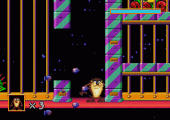
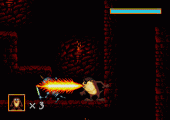
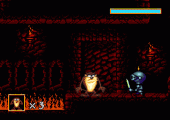
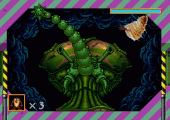
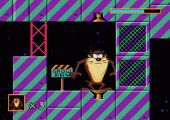
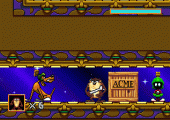

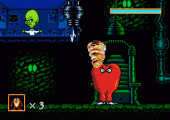

Pingback: Video Game Reviews and Articles | The Essential Malady
Pingback: Video Game Reviews & Articles | The Essential Malady
Pingback: Sega-16 Articles |
Slightly better than its predecessor. The level design has improved, and Taz now has a bigger range of moves. In return, music and SFX have taken a hit. The game is okay if your frustration tolerance is high enough. Also, it pays a lot of homage to several 50s-era Warner Bros cartoons, which is a very nice touch. 6/10.